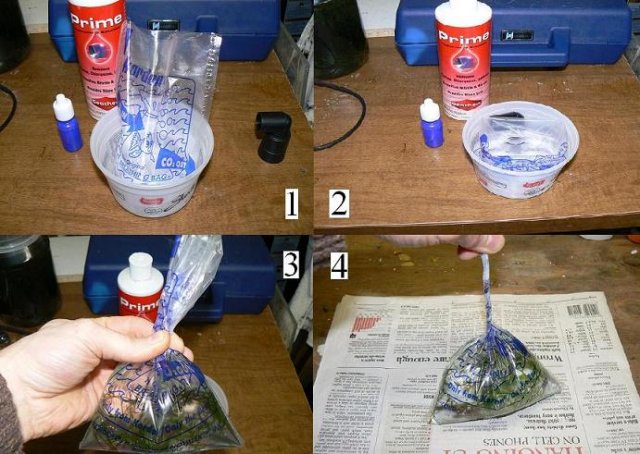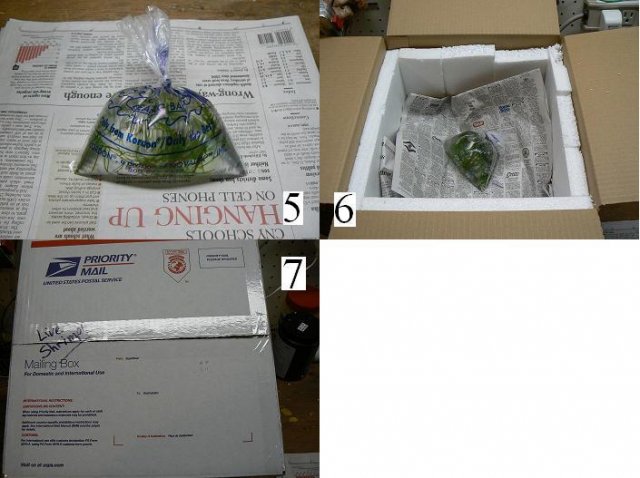Shipping Shrimp in Breather Bags
Below is how I ship shrimp using Kordon Breather Bags.
Carrier
I use United States Postal Service and ship via Priority Mail. If you use their online Click-N-Ship feature for preparing the labels, delivery confirmation is free!
Bagging
I do not starve my shrimp before shipping and I use food to lure the shrimp to one spot where I can net them easily. While waiting for the shrimp to come to the food, take a 5.5”X8” Kordon Breather Bag and place it in a dish that will hold the bag plus water. Fill the bag with 8oz. of water from the tank the shrimp are in (Pic 1). I prefer to do my weekly water change a day or two before shipping. 8oz of water is sufficient for 12 juvenile or sub-adult shrimp, 12oz works for 24. Either way, add one drop of Prime to help alleviate any accumulating ammonia during the trip. Roll the bag down so that it is an inch or so above the water line (Pic 2). It may be necessary to place a small object in the container holding the bag of water so that the water does not spill or tip over. Net the shrimp and place them into the bag. Once you are sure the correct number of shrimp is in the bag, add plants for the shrimp to cling to. Unroll the bag and lift it by the top. Pinch the bag so there is no air in it (Pic 3) and twist the tag end (Pic 4). Tie the end and cinch it down to make the bag semi-firm yet just a little squishy (Pic 5). I use one bag for 8oz of water and double bag 12oz of water - place the sealed bag of shrimp in another bag and tie. One useful trick to tying these bags, especially with the added water, is they stretch fairly easy. Once you have the spot for the knot, any extra bag above that point can be stretched to make it long enough to tie a knot. A couple quick points: make sure you didn’t just clip your fingernails and take a minute to put down a clean piece of newspaper or wipe the bench top you’re working on to eliminate the possibility of a foreign object piercing the bag. Now that the shrimp are bagged, they need to be boxed.
Boxing
You can order boxes for free at USPS - The United States Postal Service (U.S. Postal Service). I prefer the 12X12X8 boxes. They allow more space for insulation and protection than the smaller boxes. The size difference doesn’t affect shipping costs either. You want to fill the box about ½-way with filler material, then add the bag of shrimp, and then fill the rest with filler material. I like to place the bag on a piece of newspaper after filling the box ½-way to prevent the bag from settling into the filler material (Pic 6). Depending on temperatures, you can use filler material only or line the box with Styrofoam and then add filler material. Most think of insulation only for cold weather, but excess heat requires added insulation to keep the interior temps more consistent too. I’ve used many different filler materials including crumpled newspaper (readily available and fairly easy to use), foam peanuts (I recommend the pink, softer ones), bubble wrap (works but do not wrap breather bags with flat side of bubble wrap as it reduces/prevents gas exchange), soft “egg crate” foam (works well, usually not readily available) and the air pillows/bags. Other materials could be used too. The filler material acts as insulation and also as cushioning for the bag of shrimp. The key, in my opinion, is to use enough filler but not too much. When you rotate the box after it’s all closed up, there should be a little movement inside. If I had to put a quantitative figure to it, I’d say the bag should move no more than ½” in any direction. If the box is overfilled and the bag is stressed, any added stress, like dropping or crushing, could cause a leak. Once the box is filled to satisfaction, seal all seams with tape and label it (Pic 7). I label my packages with “Live Shrimp” but it wouldn’t hurt to also use a “Fragile” and/or “Perishable” markings as well.
Multiple bags
Using the 5.5”X8” bags and 12”X12”X8” boxes, I send up to 5 bags in one box. The only variation from the above procedure is to make sure there is some filler material between individual bags. I arrange the bags like the 5 dots on game dice.
Heat Packs
Heat packs are very useful but there is a real potential to overheat shrimp. Better to be too cool than too warm. They come with instructions. I don’t consider heat packs until daytime temps are below 40F. Ask your carrier when and how the package is handled. Does it leave the drop off place immediately? How is it transported to the next site? Could there be a time when the package is left outside in a truck? Some post offices have only one dispatch time in the evening; some have multiple times during the day. You don’t want to drop off a box with a heatpack at 8 a.m. and have it sit in a heated room until 5p.m.!
There are various lengths of time heatpacks work. Most commonly used are 40hr, 60hr, and 72hr. or variants of these times. 30hr and 20hr packs are also available. For priority shipping through USPS, use the 60hr or 72hr pack. Check the weather forecast for your area and the area the package is going to.


Below is how I ship shrimp using Kordon Breather Bags.
Carrier
I use United States Postal Service and ship via Priority Mail. If you use their online Click-N-Ship feature for preparing the labels, delivery confirmation is free!
Bagging
I do not starve my shrimp before shipping and I use food to lure the shrimp to one spot where I can net them easily. While waiting for the shrimp to come to the food, take a 5.5”X8” Kordon Breather Bag and place it in a dish that will hold the bag plus water. Fill the bag with 8oz. of water from the tank the shrimp are in (Pic 1). I prefer to do my weekly water change a day or two before shipping. 8oz of water is sufficient for 12 juvenile or sub-adult shrimp, 12oz works for 24. Either way, add one drop of Prime to help alleviate any accumulating ammonia during the trip. Roll the bag down so that it is an inch or so above the water line (Pic 2). It may be necessary to place a small object in the container holding the bag of water so that the water does not spill or tip over. Net the shrimp and place them into the bag. Once you are sure the correct number of shrimp is in the bag, add plants for the shrimp to cling to. Unroll the bag and lift it by the top. Pinch the bag so there is no air in it (Pic 3) and twist the tag end (Pic 4). Tie the end and cinch it down to make the bag semi-firm yet just a little squishy (Pic 5). I use one bag for 8oz of water and double bag 12oz of water - place the sealed bag of shrimp in another bag and tie. One useful trick to tying these bags, especially with the added water, is they stretch fairly easy. Once you have the spot for the knot, any extra bag above that point can be stretched to make it long enough to tie a knot. A couple quick points: make sure you didn’t just clip your fingernails and take a minute to put down a clean piece of newspaper or wipe the bench top you’re working on to eliminate the possibility of a foreign object piercing the bag. Now that the shrimp are bagged, they need to be boxed.
Boxing
You can order boxes for free at USPS - The United States Postal Service (U.S. Postal Service). I prefer the 12X12X8 boxes. They allow more space for insulation and protection than the smaller boxes. The size difference doesn’t affect shipping costs either. You want to fill the box about ½-way with filler material, then add the bag of shrimp, and then fill the rest with filler material. I like to place the bag on a piece of newspaper after filling the box ½-way to prevent the bag from settling into the filler material (Pic 6). Depending on temperatures, you can use filler material only or line the box with Styrofoam and then add filler material. Most think of insulation only for cold weather, but excess heat requires added insulation to keep the interior temps more consistent too. I’ve used many different filler materials including crumpled newspaper (readily available and fairly easy to use), foam peanuts (I recommend the pink, softer ones), bubble wrap (works but do not wrap breather bags with flat side of bubble wrap as it reduces/prevents gas exchange), soft “egg crate” foam (works well, usually not readily available) and the air pillows/bags. Other materials could be used too. The filler material acts as insulation and also as cushioning for the bag of shrimp. The key, in my opinion, is to use enough filler but not too much. When you rotate the box after it’s all closed up, there should be a little movement inside. If I had to put a quantitative figure to it, I’d say the bag should move no more than ½” in any direction. If the box is overfilled and the bag is stressed, any added stress, like dropping or crushing, could cause a leak. Once the box is filled to satisfaction, seal all seams with tape and label it (Pic 7). I label my packages with “Live Shrimp” but it wouldn’t hurt to also use a “Fragile” and/or “Perishable” markings as well.
Multiple bags
Using the 5.5”X8” bags and 12”X12”X8” boxes, I send up to 5 bags in one box. The only variation from the above procedure is to make sure there is some filler material between individual bags. I arrange the bags like the 5 dots on game dice.
Heat Packs
Heat packs are very useful but there is a real potential to overheat shrimp. Better to be too cool than too warm. They come with instructions. I don’t consider heat packs until daytime temps are below 40F. Ask your carrier when and how the package is handled. Does it leave the drop off place immediately? How is it transported to the next site? Could there be a time when the package is left outside in a truck? Some post offices have only one dispatch time in the evening; some have multiple times during the day. You don’t want to drop off a box with a heatpack at 8 a.m. and have it sit in a heated room until 5p.m.!
There are various lengths of time heatpacks work. Most commonly used are 40hr, 60hr, and 72hr. or variants of these times. 30hr and 20hr packs are also available. For priority shipping through USPS, use the 60hr or 72hr pack. Check the weather forecast for your area and the area the package is going to.







